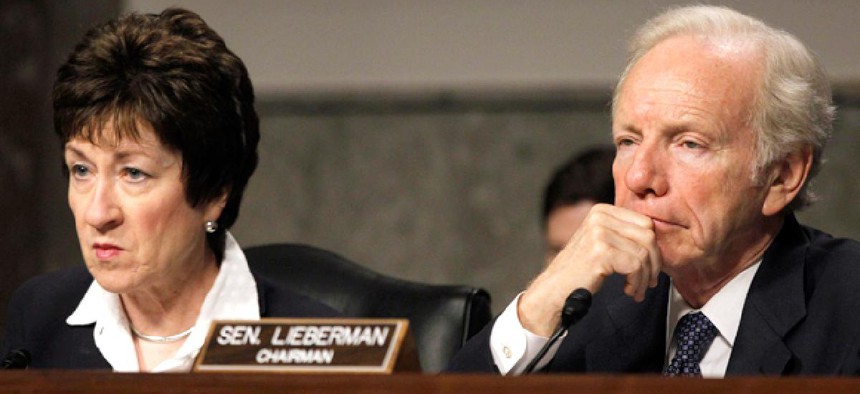
Sens. Joseph Lieberman, I-Conn. and Susan Collins, R-Maine, Charles Dharapak/AP
Defenders of fusion centers hit back at Senate panel’s criticisms
Other legislators and law enforcement veterans call report outdated and misleading.
Days after a Senate panel’s scathing critique of the Homeland Security Department’s state and local fusion centers, a chorus of defenders has emerged to rebut the report, among them legislators, law enforcement organizations and DHS itself.
On Oct. 3, the Permanent Investigations Subcommittee of the Senate Homeland Security and Governmental Affairs Committee summarized a yearlong investigation of the fusion centers that form the centerpiece of the U.S. domestic anti-terrorism strategy, with the report charging the centers produce intelligence “of uneven quality -- oftentimes shoddy, rarely timely [and] sometimes endangering citizens’ civil liberties and Privacy Act protections.”
Sen. Tom Coburn, R-Okla., who led the investigation, blamed DHS for poor implementation of the decade-old strategy of using 72 local centers to report suspicious behavior, but he also faulted Congress for failing to oversee and direct the mission.
Within hours, Homeland Security and Governmental Affairs Committee Chairman Joe Lieberman, I-Conn., distanced himself from the report, which Sen. Carl Levin, D-Mich., also signed. “I strongly disagree with the report’s core assertion that ‘fusion centers have been unable to meaningfully contribute to federal counterterrorism efforts,’ ” Lieberman said. “This statement is not supported by the examples presented in the report and is contrary to the public record, which shows fusion centers have played a significant role in many recent terrorism cases and have helped generate hundreds of tips and leads that have led to current FBI investigations.”
Though he agreed that some fusion centers may have used grants inappropriately, Lieberman noted the director of national intelligence and the FBI director acknowledged the value of centers. He faulted the congressional investigators for not reviewing final intelligence reports prepared in Washington that used raw information from the centers. And he detailed fusion centers’ contributions to recent law enforcement cases involving domestic Islamic extremists.
House Homeland Security Committee Chairman Peter King, R-N.Y., also was skeptical. “Certainly, information sharing and the fusion center network are worthy topics of congressional oversight,” he said in a statement. “ However, I agree . . . that the subcommittee report issued this week paints with too broad a brush an incomplete picture that fails to recognize many of the important contributions that fusion centers have made in securing our homeland.” The House panel, he added, will publish its own review of fusion centers.
The report also was condemned in a joint statement by the International Association of Chiefs of Police, National Sheriffs Association, Major Cities (Police) Chiefs Association, Major County Sheriffs Association, National Governors Association Homeland Security Advisors Council, National Narcotics Officers Coalitions Association, National Fusion Center Association, and Association of State Criminal Investigative Agencies.
Citing the value of the centers in pursuing an “all crimes approach,” the law enforcement groups said, “the report displays a fundamental disconnect and severe misunderstanding of the federal government’s role in supporting state and locally owned and operated fusion centers and the critical role that fusion centers play in the national counterterrorism effort. Even more alarming is the fact that the report misrepresents the findings and recommendations of the 9/11 commission, which called for increased information and intelligence sharing between and among federal, state, local and tribal law enforcement agencies.”
Thomas J. O'Reilly, who until April directed the Justice Department’s Nationwide Suspicious Activity Reporting Initiative and is now executive director of the Police Institute at Rutgers University, told Government Executive that the investigators failed to interview a number of the fusion centers that have achieved “positive successes in the counterterrorism and street crime area. A sole focus on counterterrorism in this day and age is not realistic, though it was understandable” in the early days of DHS funding. As an analogy, he cited the Transportation Department’s building of Interstate 95 from Maine to Florida knowing that locals will use the highway for shorter strips.
O’Reilly also noted that fusion centers in the past year have helped produce some 25,000 fully vetted Suspicious Activity Reports and have helped train some 250,000 officers in how to file reports without racial profiling and violating citizen privacy. “I don’t disagree with some of the report’s observations,” he added, “but by not using a valid baseline, it has set us back in many ways.”
DHS, which criticized the report as “out-of-date and misleading” on the day of its release, issued an updated statement Oct. 5. “Of particular concern is that the committee refused to review relevant data, including important intelligence information pertinent to their findings, in preparing their report,” spokesman Peter Boogaard said. “Not only does the report rely on limited data from two to three years ago in its analysis, much of what it identifies as problematic had been identified and rectified by DHS prior to their investigation. The report also fundamentally misunderstands the role of the federal government in supporting fusion centers and overlooks the significant benefits of this relationship to both state and local law enforcement and the federal government.”
Clarification: An earlier version of this story used material released inadvertently by the office of Sen. Susan Collins, R-Maine.
NEXT STORY: Play of the Day -- Romney is getting cocky







